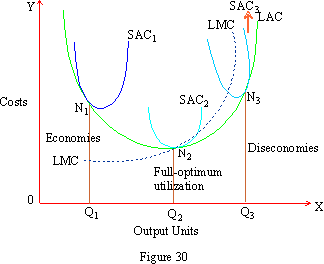|
v) Long Run Cost Curves: So far we have studied Cost Analysis in the short run. We have assumed that only labor and raw materials are variable factors. All other factors like machines, tools, manager, factory building, etc. are fixed factors. When a firm continues to produce for a sufficiently long number of years some or all of its fixed factors can be replaced. In the long run the distinction between fixed and variable factors becomes less important. Long run of a firm can be defined as, a Period sufficiently long during which at least one (or more) of the fixed factors become variable and can be replaced.
Long run is an analytical concept. These is no fixed limit on the number of years to distinguish between short run and long run. For each variety of fixed factors, its long run depends upon its life span. Let us assume that a firm employs three factors of production with their life span given as Machine = 6 years, Manager = 10 years and Factory building = 15 years. Then for machine replacement 7 years is the long run, for replacement of manager 11 years is the long run and after 15 years all the three factors become perfectly variable or replaceable. Depending upon length of the long period, the long run cost curve will behave in one way or the other. If all the factors are perfectly variable and there are no fixed factors at all then the long run Average Cost Curve will be a horizontal line parallel to OX axis. If some of the fixed factors have an unlimited capacity to produce then the long run Average Cost Curve will continuously fall downward. If some of the factors are variable while a few other factors continue to be fixed even in the long run then LAC will be ’U’ shaped but flatter than SAC. Let us present a graph of the LAC.
vi) LAC, LMC and scale of production: Besides internal economies that a firm enjoys in the short run, it has the advantage of the scale economies in the long run. Each fixed factor with its given life span constitutes a scale of production which in the short run cannot be altered. With the passage of time each of these factors can be altered and replaced. This permits change in the scale of production. An old machine can be replaced by a new one which has better capacity, a manager can be replaced at the end of the contract period with another more qualified and experienced person. Such changes make productive activities more efficient and hence are called economies (advantages) of the scale. Since the long run goes on combining such individual advantages it is also called a chain of the short runs.
In Figure 30 we find Long run Average cost Curve (LAC) represented by a chain of three short run cost curves SAC1, SAC2 and SAC3. In between them there may be many more SACs. We have also drawn LMC which is the Long run Marginal cost Curve. It intersects LAC at the minimum point of LAC which is N2 at output level Q2.

[next page]
|
Index
9.1 -
Concept of a Firm
9.2 -
Factors of Production and Product Output
9.3 -
Costs and Profits
9.4 -
Costs Analysis
Chapter
10 |